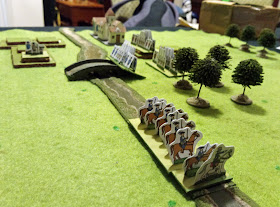Fired up after my Epic 40K Portable Wargames I went back to the ECW yesterday evening. Up until now I have mostly been trying out the rules with scenarios, but I decided to create a little process for generating straight head-to-head games simply for trying out mechanisms and balance.
I created some tables for generating random terrain, then gave each side four units - two Foot and two Horse each. I used another table to generate two more units for each side; more foot or horse or maybe some Dragoons or Artillery. This made each army six units, which I thought would be fine to give a quick game for trying out mechanisms.
I used card draws for activation; I liked how they worked for the Epic 40K games in that they force you to decide which units you want to use, whilst allowing you the chance, via a run of cards, to do a sweeping move.
For the sake of simplicity I rated all units as Average.
I used the following changes to the rules (most of which have been described elsewhere, but will be noted here for my future self to find):
(i) Units can retreat through one friendly unit behind them.
(ii) A unit only pursues once per activation.
(iii) I reduced the strength of units by one - Artillery to 1, Horse and Dragoons to 2 and Foot to 3. I thought this might strike a better balance between decisive combats whilst still allowing foot to push and shove for a bit. With easier retreats (see (i) above) combat isn't as deadly anyway.
(iv) Units in the front square of an enemy unit must move directly away from it to leave the square, unless making a pursuit or retreat move.
(v) I rated exhaustion simply on number of units lost, and didn't count Commanders as a unit for either initiative card or exhaustion purposes. Commanders were lost if the unit they were with was destroyed, or if the unit took a hit and a '6' was rolled.
(vi) Only one unit in a close combat actually scores a hit (ties are broken by highest total score, then lowest die roll)
So this was the first set-up. The Royalists, on the left, had three Foot, two Horse (defined as Gallopers) and a piece of Artillery. Parliament had four Foot and two Horse (Trotters). I set two terrain objectives - the hill near the village and the bridge.
Parliament pushed forward to take the hill and cover the bridge.
The Royalists forded the river with their horse in order to try and turn Parliament's flank.
The Royalist artillery set up, but immediately came under fire. I decided that if unlimbered artillery rolled a retreat then the crew had run for cover and that an activation was required to get them back again. Whilst in this uncrewed state, a second retreat would destroy the artillery (which can only take one hit - see above). Anyway, that's what happened; a double draw by the Parliamentarians saw them scatter the crew with one shot and then eliminate the artillery with a second.
Parliament strengthened its position.
The Royalist horse went into action, driving back the enemy Trotters.
Royalist foot had pushed boldly over the bridge, and initially made some real advances, but they were driven back and dispersed.
The Royalist now found themselves losing the cavalry action.
Parliament went on the offensive, pushing across the bridge and river.
In firm control of both objectives, and with the Royalists now prohibited from offensive action because of losses, I declared the battle for Parliament.
I set up a second game. The random terrain put a few pieces on each side's baseline, and nothing on the rest of the board. I set two squares in the centre as objectives. The Royalists had a similar force as before, except they had Dragoons instead of the Artillery. Parliament ended up with two extra Horse. I designated one as another Trotter but the fourth as a Galloper.
This time the Royalist foot pushed forward, whilst their outnumbered horse held back.
Parliament's horse attacked.
And kept attacking - they had an excellent run of activation cards which left the Royalists completely wrong-footed.
The Royalist horse was quickly defeated.
Parliament pushed their foot forward in support.
The last of the Royalist horse was dispersed.
The Royalist foot formed up and fought a brave holding action, and actually held both objectives at this stage.
The Parliamentarian commander was killed by a stray bullet.
Royalists under pressure.
Again, Parliament prevailed.
I found that the games worked quite well, and this simpler setup allowed me to concentrate far more on mechanisms than trying to work within the constraints of an historical refight would. I'm going to run through a few more games to tweak the ideas, and will then try a scenario refight.
One thing I wasn't sure about is the value of Artillery. With only six units per side, a single Artillery unit is quite a significant chunk of the force. But its value in game terms does not seem to be as high as a unit of Foot, Horse or Dragoons. I'm not sure how to adjust the balance there.
In addition I may focus a little more on there being an attacker and a defender, with the latter controlling objectives that the other must take within a time limit, but with the attacker maybe getting eight units instead of six.

























Nice concept using the Cardboard figures
ReplyDeleteLike the idea of a quick start
Also like the freedom you express experimenting with the troops characteristics